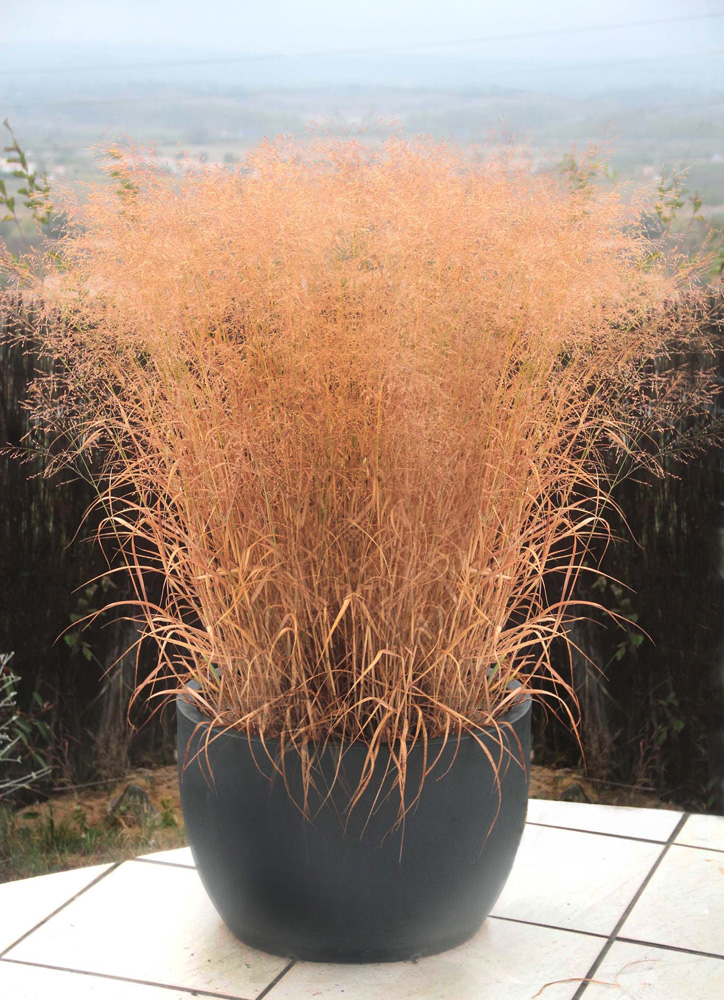October / octobre 2017
Le jardin de Roland et Liliane Leclercq, Tourbes, Hérault
The garden, 3000 sq. m. in size, is located on a clay hillside, overlooking the village of Tourbes, with a view of the surrounding countryside to Mont St Clair (near Sète). The natural vegetation consists of Aleppo pines and both green and white oaks. The hard landscaping of the garden was started in 2012 as well as the first plantings. The layout, composition and choice of plants took into account the nature of the soil, the effect of competition from the roots of the existing large trees, and the Mediterranean climate.
Le jardin, d’une superficie de 3000m2 est situé sur une colline argileuse, dominant le village de Tourbes, avec une vue sur la campagne environnante jusqu’au Mont St Clair (à Sète). La végétation initiale est constituée de pins d’Alep, chênes verts, chênes blancs. La structure du jardin a commencé dès 2012, ainsi que le début des plantations. L’aménagement, la composition, le choix des plantes ont pris en compte la nature du sol, la concurrence racinaire des grands arbres présents, et le climat méditerranéen.
Roland and Liliane began by creating the path that climbs to the house. It is framed by dry stone walls and by slopes covered with rosemary and other Mediterranean plants, for example Rosmarinus officinalis ‘Bonifacio’ which ties the structure together.
Roland et Liliane ont commencé par le chemin d’accès qui monte à la maison, encadré de murs de pierres sèches et de talus couverts de plantes méditerranéennes et de romarins comme Rosmarinus officinalis ‘Bonifacio’ qui épousent le relief.
In front of the house the terrace overlooks a garden planted with mild climate species that set off the pool and the uninterrupted view of Mont St Clair, both by their shapes and by their soft shades of green, grey and blue: Acacia covenyi, A. pravissima, A. x hanburyana, Buddleja ‘Lochinch’, ceanothus.
A l’avant de la maison la terrasse donne sur un jardin planté d’essences de climat doux qui mettent en valeur la piscine et la vue très dégagée sur le Mont St Clair, tant par leur port que par leurs teintes aux nuances de vert, gris, bleu…Acacia covenyi, A. pravissima, A. x hanburyana, Buddleja ‘Lochinch’, céanothes.
To access the back of the house we took a wide staircase bordered with cacti, agapanthus, grasses and acanthus. We came out onto a plateau where pebbled pathways led to different areas of the garden, each with a different atmosphere: a space for relaxing, a table for meals, a barbecue, a boules pitch.
Pour accéder à l’arrière de la maison on emprunte un large escalier bordé de cactées, d’agapanthes, de graminées, d’acanthes… Nous arrivons alors sur un plateau parcouru de calades menant à des secteurs de jardins offrant des ambiances différentes, salons d’été, table pour repas et grillades, terrain de boules.
Plants in the rockeries and beds were chosen for their structural qualities and for their resistance to drought and cold. The heather rockery included Erica manipuliflora and E. multiflora as well as Euphorbia pithyusa, Artemisia abrotanum and ground covers such as thyme and helianthemum. Another bed was composed of waves of blues and yellows: Salvia candelabrum, S. ‘Amparito’, S. ‘Allen Chickering’, S. ‘Amistad’, Caryopteris x clandonensis, Achillea filipendulina, Senecio cineraria, and clusters of grasses including Pennisetum sp., Miscanthus sinensis ‘Yaku Jima’, Stipa tenuifolia, and S. gigantea.
Rocailles et massifs où les plantes ont été choisies pour leur résistance à la sécheresse, au froid, et leur port. Rocailles par exemple avec bruyères (Erica manipuliflora, E. multiflora), Euphorbia pithyusa, Artemisia abrotanum, couvres-sols (thyms, Helianthemum sp.). Massif par exemple composé de vagues de couleurs bleues et jaunes (Salvia candelabrum, S. ‘Amparito’, S. ‘Allen Chickering’, S. ‘Amistad’, Caryopteris x clandonensis, Achillea filipendulina, Senecio cineraria….) avec des trames de graminées (Pennisetum sp., Miscanthus sinensis ‘Yaku Jima’, Stipa tenuifolia, S. gigantea).
Metal arches covered with climbing plants (Rosa banksiae ‘Lutea’, Rosa ‘Narrow Water’, Akebia quinata, Solanum jasminoides) open onto the various sectors of the garden, each one with a distinctive ‘calade’ (a rustic pavement made from natural stones or pebbles).
Des arceaux couverts de plantes grimpantes (Rosa banksiae ‘Lutea’, Rosa ‘Narrow Water’, Akebia quinata, Solanum jasminoides) ouvrent sur les différents secteurs du jardin au gré des calades.
Great care has also been taken to provide a rich and varied plant palette, to create interesting associations of foliage and flower colour and, as plant enthusiasts, to seek out lesser-known plants. Fauna has not been forgotten and bird baths have been built into the low walls.
Un grand soin aussi a été porté sur la richesse de la palette végétale par les associations de couleurs de feuillages, de floraisons, et par la recherche d’amateurs éclairés pour des plantes moins connues. La faune n’a pas été oubliée et quelques bains d’oiseaux apparaissent dans les murets.
This garden reflects the passion of the gardeners, Liliane and Roland, and the sense of welcome and conviviality of its creators. More details can be found in their garden diary.
Ce jardin reflète la passion des jardiniers, Liliane et Roland, le sens de l’accueil et la convivialité des créateurs. Plus de détails peuvent être trouvés dans leur blog de jardin.
Text et photos : Michèle et Daniel Auvergne
Translation into English : Roland Leclercq
![]()















